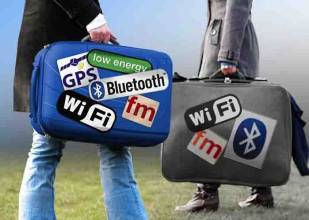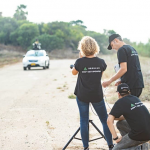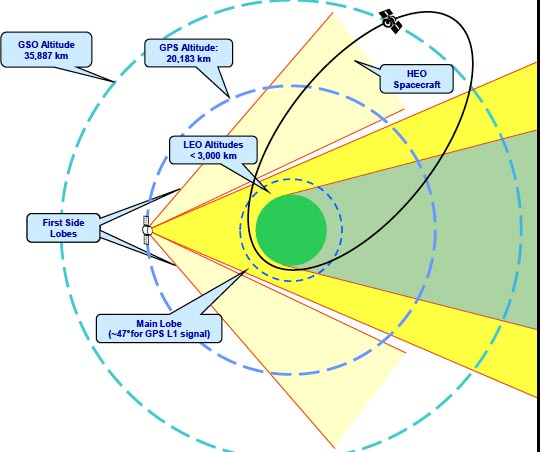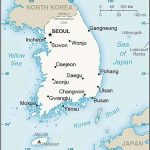Test results from the long-running Adjacent Band Compatibility (ABC) Assessment show interference from wireless signals in nearby bands could negatively impact GPS receivers kilometers away from Long-Term Evolution (LTE) ground stations and render some more closely located GPS receivers useless.
Test results from the long-running Adjacent Band Compatibility (ABC) Assessment show interference from wireless signals in nearby bands could negatively impact GPS receivers kilometers away from Long-Term Evolution (LTE) ground stations and render some more closely located GPS receivers useless.
The Assessment sprang from the controversy surrounding the ground-based wireless network proposed by LightSquared in 2010. Researchers at the Department of Transportation (DoT) have been working to determine a series of interference masks — that is power limits by frequency — for the spectrum stretching 100 megahertz on either side of the GPS L1 signal centered at 1575.42 MHz. The goal is to have a way to estimate interference risk of future proposals before extensive resources are invested.
The yardstick being used to determine when interference occurs is a one-decibel degradation in the carrier-to-noise density ratio (C/N0). This a practical and internationally accepted standard, explained Capt. Frank Clark of the Air Force’s GPS Directorate in a presentation on the subject. LightSquared, which is now named Ligado, objects to using C/N0, pushing instead for using changes in position error to determine interference — a standard that favors LTE and does not fully reflect the risk to receivers, explained Logan Scott, in an earlier interview. Scott is the owner of LS Consulting in Colorado and an expert on radio frequency signal processing and waveform design for communications, navigation, radar and emitter location.
The Assessment has developed masks to protect both existing and future receivers. Tests on 80 receivers were done last April with initial results presented October 14, 2016 in Washington. Of the six receiver categories tested — cellular, general location/navigation, general aviation, timing, high precision and space receivers — high precision receivers were, not unexpectedly, the devices most effected. The new charts, shared during the final workshop held March 30, 2017 in Washington, illustrated the distances at which high precision and other receivers could be negatively impacted.
"So the ABC test, just to be very clear on this, basically tested a bunch of different receiver types to establish at what level do you get 1 dB of degradation … (then it) takes those results and interprets them to say: ‘Here’s the associated range. Here’s what it means from a range perspective,’ " explained Scott.
The analysts working with the data chose to chart the range of impact of three of the 22 frequencies identified for testing in the test plan—1475 MHz, 1530 MHz, and 1630 MHz. Those three frequencies were chosen because they represented the lowest frequency tested and two frequencies in bands proposed for use by LightSquared, which was renamed Ligado in 2016, said one source, who spoke on condition of anonymity.
Ligado proposed to rezone frequencies near those used by GPS, bands originally intended to support satellites. The firm sought permission to use them for a high-powered broadband network with tens of thousands of ground stations — a request that was put on hold by spectrum regulators in 2012, forcing the firm into bankruptcy soon after. Ligado modified its proposal after emerging from Chapter 11 in 2015. It dropped the most problematic frequencies from 1545 to 1555 MHz, electing instead to use 1526-1536 MHz for downlink and 1627.5-1637.5 MHz and 1646.5-1656.5 for uplink. The firm also requested that it be allowed to share the band 1675-1680 MHz which, with adjacent frequencies it has access to, would help make up for forgoing use of the lower band. Opposition has emerged to that sharing request, which remains unresolved.
A Range of Impacts
Taking into account antenna patterns and largely using a free-space propagation loss model, the study tested for interference assuming a Macro Rural environment, a Macro Suburban environment and a Macro Urban environment (see chart at top for power levels and other details of the assumptions).
Some results were quite striking. Cell phone receivers showed impact in the 1530 MHz Macro Urban model, but only for about 80 meters and starting at about 10 meters above the ground. General location/navigation receivers, however, were impacted at the 1 dB level up to four kilometers from the tower and completely lost satellite lock up to 85 meters from the tower. To see the presentation, click here.
The interference at 1530 MHz made timing receivers within about 220 meters of the tower in the Macro Urban model lose lock on all satellites — effectively rendering them useless. It also impacted the ability of timing receivers up to 500 meters away to lock onto low elevation GNSS satellites. Timing receivers for more than one kilometer around the tower suffered 1 dB degradation.
High precision receivers were the most impacted, experiencing 1 dB degradation up to 14 kilometers away and at heights of nearly two kilometers. Complete loss of lock, according to the chart, would occur within approximately one kilometer while receivers up to three kilometers away would lose lock on low elevation satellites.
Just lowering the transmit power would not resolve the issue, said Scott. "The problem you have as a cellular operator is you want to have a fair amount of power there because that sets the signal to noise ratio. If you set that value too small then instead of getting four bars, you get no bars — in other words you’re not providing coverage."
To offset that you would need more towers — "a lot more towers," said Scott. That leads to a problem of GPS receivers receiving power from multiple towers, and the power starts to aggregate.
"This (study) is all single power kind of stuff," said Scott, "and, in fact, in a real deployment the situation would probably be worse because you don’t just deploy one tower. You put on a lot of different towers and usually they have overlapping coverage."
Ligado — which had a number of people in attendance at the workshop plus representatives of Roberson and Associates, which has done research for Ligado, and other advocates both in the room and on the phone connection — took issue with many aspects of the Assessment. Ligado-connected speakers expressed frustration at not getting confidential data on specific receivers and questioned the choice of the propagation models used in the tests. For example, as noted above, the study used primarily a free-space path loss model though the charts said an Irregular Terrain Model (an improved version of the Longley-Rice Model) would be considered for inclusion the final report.
"It seems the results are highly dependent on the choice of propagation model," said Ken Zdunek of Roberson and Associates, who asked why the team chose the models it did.
"The 2011 TWG (technical working group) tests clearly showed that there is significant statistical variation — path loss and propagation," Zdunek said. "You haven’t taken that into account at all and that is, in fact, a key element of one of the NTIA recommendations for measuring propagation. So, we’re just wondering what are we to do with these? Do we believe any of them?"
[The NTIA, that is the National Telecommunications and Information Administration, represents the government interests on spectrum matters.]
Hadi Wassaf of DoT’s Volpe Center said the free-space model may be conservative but pointed out that if one goes to a two-ray model, the picture could actually get worse.
Feedback from users, MITRE’s Chris Hegarty told Zdunek, "suggests that for almost every receiver category we really do need to be concerned about receivers being within meters, or 100s of meters, of at least a single transmitter. And it turns out, if you look at ITM (Irregular Terrain Model), or anything else, if you really believe you want to protect everything 100 meters from the transmitter then almost all these models become free-space."
Hegarty added that NTIA had configured ITM exactly the same as free-space up to 100 meters for a key 2011 report prepared by the National Space-Based Positioning, Navigation, and Timing Systems Engineering Forum (NPEF).
The next step is a final report, said Karen Van Dyke, of the Office of the Assistant Secretary for Research & Technology (OST-R) at DoT, which is leading the study. That would appear to wrap up what is supposed to be the first part of a two-part effort with the next part looking at receivers incorporating new signals from the world’s emerging constellations.
Ligado, however — which has opposed the ABC Assessment at every turn — came out against doing any more work on the Assessment. It asserted that the studies it sponsored, which have in some cases created friction with the GPS community, should be enough.
“Today’s workshop," the company said in a statement, "the sixth since OST-R set out to study this matter nearly 1,000 days ago, should be the last. While the study’s lack of transparency and reliance on an irrelevant and unreliable metric call into question its usefulness, the substantive work done by others to solve legitimate concerns during this time make it impossible to see how OST-R could justify allocating any additional taxpayer resources on something that’s already been resolved.”





